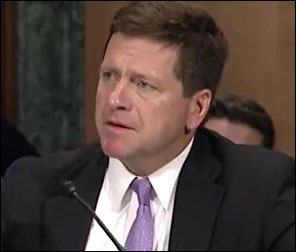By Pam Martens and Russ Martens: December 4, 2017

SEC Chair Jay Clayton Responds to Questioning During Senate Banking Committee Hearing, September 26, 2017
On November 8, the Securities and Exchange Commission (SEC) Chairman, Jay Clayton, delivered a speech at the Practising Law Institute’s 49th Annual Institute on Securities Regulation. His focus was transparency on Wall Street and he had this nugget of wisdom to share with the audience:
“Looking back at enforcement actions, a common theme emerges – where opacity exists, bad behavior tends to follow. As Joseph Pulitzer said: ‘There is not a crime, there is not a dodge, there is not a trick, there is not a swindle, there is not a vice which does not live by secrecy.’ The remainder of my remarks will concentrate on topics that have proven over time to be fertile ground for fraud on investors. The SEC may not yet have policy or rulemaking answers in these areas, but we are on the lookout for ways to fight the type of opacity that can create an environment conducive to misconduct.”
The SEC was created to police Wall Street under the Securities Exchange Act of 1934. The legislation came on the heels of the U.S. Senate holding three years of hearings that showed Wall Street to be a cesspool of opaque self dealing and collusion that had led to the 1929 stock market collapse and ensuing Great Depression. The SEC has now had 83 years to hone its investigative skills and techniques. And yet, it wore blinders in the runup to the epic Wall Street crash of 2007-2009, which was caused by the same type of corruption that was ferreted out by the U.S. Senate after the 1929 crash. Its blinders remain securely in place.
Wall Street Journal reporter, Scott Patterson, released a 354-page book in 2012 that took a hard look at U.S. market structure. It was titled: Dark Pools: High Speed Traders, A.I. Bandits, and the Threat to the Global Financial System. On page 339 of his book, Patterson writes in the notes section: “The title of this book doesn’t entirely refer to what is technically known in the financial industry as a ‘dark pool.’ Narrowly defined, dark pool refers to a trading venue that masks buy and sell orders from the public market. Rather, I argue in this book that the entire United States stock market has become one vast dark pool. Orders are hidden in every part of the market. And the complex algorithm AI-based trading systems that control the ebb and flow of the market are cloaked in secrecy. Investors – and our esteemed regulators – are entirely in the dark because the market is dark.” (The italics in this excerpt are as they appear in the hardcover book.)
The actual dark pools operated by some of the biggest banks on Wall Street are one of the most opaque parts of Wall Street. They are, effectively, unregulated stock exchanges run internally by the same serially charged banks that have engaged in collusion in other markets. And yet, the SEC has taken no action to outlaw them, even looking the other way as they trade the shares of their own bank. (See Wall Street Banks Are Trading in Their Own Company’s Stock: How Is This Legal?)
Further enshrining opacity and corruption on Wall Street is that the SEC has failed miserably in using its bully pulpit to end Wall Street’s private justice system. This journey into judicial darkness began in the 1980s. After tens of millions of dollars were spent by Wall Street and its lobbyists, the U.S. Supreme Court gave a green light to the practice in its 1987 decision, Shearson/American Express v. McMahon.
Since then, cases filed against Wall Street firms by both customers and workers, which could serve as an early warning system to patterns of fraud if aired in a courtroom open to the public and press, have been moved into the dark shadows of a private justice system that claimants believe is rigged against them.
Then there is what looks like intentional technical incompetence at the SEC in its multi-decade failure to launch an effective Consolidated Audit Trail (CAT) so that it can detect manipulative or illegal trading by the most sophisticated trading houses in the world. (JPMorgan Chase has bragged about having “more software developers than Google, and more technologists than Microsoft.” )
And, finally, if the SEC was genuinely serious about aiding the case of transparency, why was it shredding all of its investigative files until one of its own attorneys had to blow the whistle? In 2011, SEC Attorney Darcy Flynn explained to Congressional investigators and the SEC Inspector General that for at least 18 years, the SEC had been shredding documents and emails related to its investigations — documents that the law required it to keep. Flynn told investigators that by purging these files, it impaired the SEC’s ability to see the connections between related frauds.
Altruistic speeches notwithstanding, the SEC remains a captured regulator and the public continues to be fleeced by Wall Street’s institutionalized wealth transfer system as a result.

